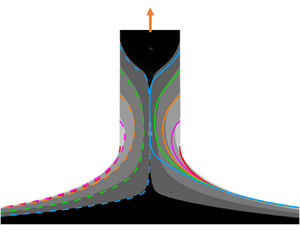Published online by Cambridge University Press: 07 July 2021

In this paper we investigate the statics and the dynamics of large-viscosity ligaments attached to a rod and drawn out of a pure-liquid bath. Following the similar work of films pulling out of a bath (Champougny et al., J. Fluid Mech., vol. 811, 2017, pp. 499–524), a one-dimensional model is applied to describe the ligaments drawn at constant velocities. We focus on the whole drawing dynamics of the ligament up to breakup, for which the breakup height is determined. The breakup height coincides with the maximum static meniscus height for very slow drawing, whose process can be described by quasi-static solutions. We present the numerical results of the static menisci and analytically unravel the mechanism in the low gravity case. Starting from a stable static meniscus, the breakup height of faster drawing depends separately on the rod radius and the drawing velocity, the latter dependency being fully determined by considering the agravic limit. Next, it is shown that the entire lifetime of the ligament drawing can be sequenced into a ductility stage, a capillarity stage and a pinch-off stage, the latter being shown to be almost instantaneous. The ductility and capillarity stages are decorrelated with the help of an approximate solution of the ductility stage, and the transition between the two stages corresponds to the time at which the capillarity-induced contraction velocity exceeds the ductility-induced one. The one-dimensional predictions of the breakup height and the entrained liquid volume attached to the rod quantitatively agree with experimental results of silicone oil ligaments, and the deviations are rationalized in comparison with a two-dimensional model.